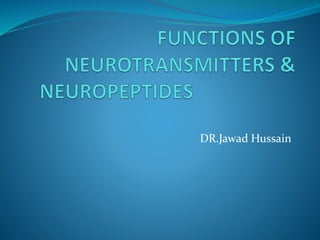
Neurotramsitters and Neuromodulators SlideShare
- 2. ` Nerve endings called biological transducers that convert electrical energy into chemical energy. This conversion process involves the synthesis of the neurotransmitters, their storage in synaptic vesicles, and their release by the nerve impulses into the synaptic cleft. The secreted transmitters then act on appropriate receptors on the membrane of the postsynaptic cell and are rapidly removed from the synaptic cleft by diffusion, metabolism, and, in many instances, reuptake into the presynaptic neuron.
- 3. ` Some chemicals released by neurons have little or no direct effects on their own but can modify the effects of neurotransmitters. These chemicals are called neuromodulators
- 4. Neurotransmitters and neuromodulators can be divided into two major categories: 1.small-molecule transmitters and 2. large-molecule transmitters. Small-molecule transmitters include monoamines (eg, acetylcholine, serotonin, histamine), catecholamines (dopamine, norepinephrine, and epinephrine), and amino acids (eg, glutamate, GABA, glycine).
- 5. ` Large-molecule transmitters include a large number of peptides called neuropeptides including substance P, enkephalin, vasopressin.
- 6. There are also other substances thought to be released into the synaptic cleft to act as either a transmitter or modulator of synaptic transmission. These include purine derivatives like adenosine and adenosine triphosphate (ATP) and a gaseous molecule, nitric oxide (NO).
- 7. Four diffusely connected systems of central neurons using modulatory transmitters. A) Norepinephrine-containing neurons. B) Serotonin-containing neurons. C) Dopamine-containing neurons. D) Acetylcholine-containing neurons
- 9. MONOAMINES ACETYLCHOLINE Acetylcholine( acetyl ester of choline)----that release acetylcholine (cholinergic neurons). Synthesis of acetylcholine involves the reaction of choline with acetate.
- 10. LOCATION Acetylcholine is the transmitter at the 1. Neuromuscular junction 2. Autonomic ganglia 3. Postganglionic parasympathetic nerve-target organ junctions and some postganglionic sympathetic nerve-target junctions. 4. In the brain, including the basal forebrain complex and pontomesencephalic cholinergic complex .
- 11. Cholinesterases Acetylcholine must be rapidly removed from the synapse if repolarization is to occur. The removal occurs by way of hydrolysis of acetylcholine to choline and acetate, a reaction catalyzed by the enzyme acetylcholinesterase.
- 12. Serotonin Serotonin is formed in the body by hydroxylation and decarboxylation of the essential amino acid tryptophan. After release from serotonergic neurons, much of the released serotonin is recaptured inactivated by monoamine oxidase (MAO) to form 5- hydroxyindoleacetic acid (5-HIAA). This substance is the principal urinary metabolite of serotonin.
- 13. LOCATION Serotonin (5-hydroxytryptamine; 5-HT) is present 1. Blood platelets and in gastrointestinal tract, where it is found in the enterochromaffin cells and the myenteric plexus. 2. Brain stem in the midline raphé nuclei which project to portions of the hypothalamus, the limbic system, the neocortex, the cerebellum, and the spinal cord.
- 16. CATECHOLAMINES Norepinephrine & Epinephrine: The chemical transmitter present at most sympathetic postganglionic endings is norepinephrine. Norepinephrine and epinephrine, are secreted by the adrenal medulla. There are also norepinephrine-secreting and epinephrine-secreting neurons in the brain.
- 17. Biosynthesis & Release of Catecholamines The principal catecholamines found in the body—norepinephrine, epinephrine, and dopamine—are formed by hydroxylation and decarboxylation of the amino acid tyrosine.
- 18. Excitatory & Inhibitory Neuorotransmitters GLUTAMATE The amino acid glutamate , excitatory transmitter in the brain and spinal cord. Glutamate is formed by reductive amination of the Krebs cycle intermediate -ketoglutarate in the cytoplasm.
- 19. GABA GABA ---- inhibitory mediator in the brain responsible for presynaptic inhibition. formed by decarboxylation of glutamate. The enzyme that catalyzes this reaction is glutamate decarboxylase (GAD), which is present in nerve endings in many parts of the brain.
- 20. GLYCINE Glycine has both excitatory and inhibitory effects in the CNS. Glycine is responsible direct inhibition, primarily in the brain stem and spinal cord.
- 21. ` Three kinds of neurons are responsible for direct inhibition in the spinal cord: 1. Neurons that secrete glycine, 2.Neurons that secrete GABA, and 3.Neurons that secrete both.
- 23. NEUROPEPTIDE Any of the molecules composed of short chains of amino acids (endorphins, enkephalins, vasopressin, etc.) Chains of 2 to 40 amino acids Stored in axon terminal as larger secretory granules (called dense-core vesicles) Act at lower concentrations Longer lasting effects Some function as hormones Modify actions of neurotransmitters To date there are around fifty peptides, which are known to act as neuronal messengers. Substance P, gastrin, cholecystokinin (CCK) neuropeptide Y, enkephalin and endorphoin.
- 25. COMPARISON OF CLASSICAL NEUROTRANSMITTER AND NEUROPEPTIDE IN LENGTH SITE OF SYNHESIS CYTOSOL OF SYNAPTIC KNOB ENDOPLASMIC RETICULUM AND GOLGI COMPLEX IN CELL BODY TRAVEL TO SYNAPTIC KNOB BY AXONAL TRANSPOR SITE OF STOTRAGE IN SMALL SYNAPTIC VESSELS IN AXONLA TERMINALS IN LARGE DENSE-CORE VESICLES IN AXON TERMINAL SPEED & DURATION OF ACTION RAPID, BRIEF RESPONSE SLOW; PROLONGED RESPONSE SITE OF ACTION SUBSYNAPTIC MEMBRANE OF POSTSYNAPTIC CELL NONSYNAPTIC SITES ON EITHER PRESYNAPTIC OR POSTSYNAPTIC CELL AT MUCH LOWER CONCENTERATION THAN CLASSICAL NEUROTRANSMITTER EFFECT USUALLY ALTER POTENTIAL OF POSTSYNAPTIC CELL BY OPENING SPECIFIC ION CHANNELS USUALLY ENHANCE OR SUPPRESS SYNAPTIC EFFECTIVENESS BY LONG TERM CHANGES IN NEUROTRANSMITER SYNTHESIS OR POSTSYNAPTIC RECEPTOR SIES
- 26. How Do Newly Synthesis Proteins (NTs) travel to the Axon Terminal So Quickly? Micotubules and motor proteins are needed for transport of vesicles quickly to the axon terminal or synaptic knob. Newly synthesized membrane and secretory proteins destined for the axon travel by fast anterograd transport
- 27. What is Retrograde transport? This is transport in the opposite direction. Used mainly to transport “empty” vesicles to soma for reloading purposes. Again, motor proteins and microtubules work are at instrumental here.